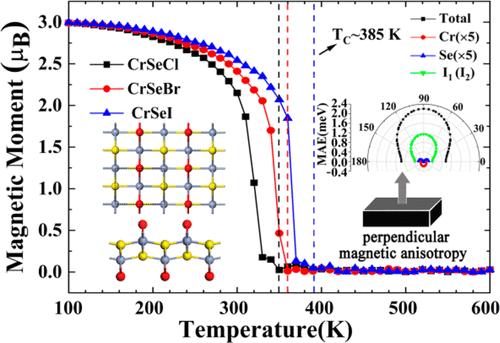当前位置:
X-MOL 学术
›
J. Phys. Chem. C
›
论文详情
Our official English website, www.x-mol.net, welcomes your
feedback! (Note: you will need to create a separate account there.)
Prediction of Novel 2D Intrinsic Ferromagnetic Materials with High Curie Temperature and Large Perpendicular Magnetic Anisotropy
The Journal of Physical Chemistry C ( IF 3.3 ) Pub Date : 2020-03-31 , DOI: 10.1021/acs.jpcc.0c01307 Ruilin Han 1 , Zhou Jiang 2 , Yu Yan 3
The Journal of Physical Chemistry C ( IF 3.3 ) Pub Date : 2020-03-31 , DOI: 10.1021/acs.jpcc.0c01307 Ruilin Han 1 , Zhou Jiang 2 , Yu Yan 3
Affiliation

|
Two-dimensional intrinsic ferromagnets with high Curie temperature and large perpendicular magnetic anisotropy (PMA) are promising candidates for data storage and spintronics applications. In this work, first-principle calculations and Monte Carlo simulation are used to investigate the stability, electronic structure, and magnetic anisotropy of monolayers of CrSeX (X = Cl, Br, I). It is found that monolayer CrSeX (X = Cl, Br, I) species are two-dimensional intrinsic ferromagnets and are thermally stable at room temperature. It is worth noting that the Curie temperatures of monolayer CrSeX (X = Cl, Br, I) can reach or even exceed room temperature, and a strong PMA can be obtained in monolayer CrSeI. Interestingly, the PMA of monolayer CrSeI is mainly provided by the nonmetallic I atom with large spin–orbit coupling and magnetic anisotropy of the nonmetallic I atom reaching up to 0.572 meV/I atom, which is comparable to that of metallic Fe atoms at Fe/MgO interfaces. In contrast to monolayer CrSeI, monolayer CrSeCl and CrSeBr possess weak in-plane magnetic anisotropy, and their easily magnetized direction is the [100] axis. By analyzing the projected density of states and the p-orbital-resolved magnetic anisotropy energy of the nonmetallic I atom based on second-order perturbation theory, we find that the large PMA of monolayer CrSeI is mainly provided by the matrix element difference between the spin-up px and py states of the nonmetallic I atoms, and the difference between it and the matrix element difference between the spin-up py and pz states of the nonmetallic I atoms in the case of the magnetic moment aligning [100] and [010] axes is the reason why the energy of monolayer CrSeI for the magnetic moment aligning [100] axis is smaller than the energy for the magnetic moment aligning [010] axis. This study suggests that monolayer CrSeI is a promising candidate for future applications in spintronic devices.
中文翻译:

高居里温度和大垂直磁各向异性的新型二维本征铁磁材料的预测
具有高居里温度和大垂直磁各向异性(PMA)的二维固有铁磁体是数据存储和自旋电子学应用的有希望的候选者。在这项工作中,使用第一性原理计算和蒙特卡洛模拟研究了CrSeX(X = Cl,Br,I)单层的稳定性,电子结构和磁各向异性。发现单层CrSeX(X = Cl,Br,I)物种是二维本征铁磁体,并且在室温下具有热稳定性。值得注意的是,单层CrSeX(X = Cl,Br,I)的居里温度可以达到或什至超过室温,并且在单层CrSeI中可以获得很强的PMA。有趣的是 单层CrSeI的PMA主要由自旋轨道耦合大的非金属I原子提供,非金属I原子的磁各向异性达到0.572 meV / I原子,与Fe / MgO界面上的金属Fe原子相当。与单层CrSeI相比,单层CrSeCl和CrSeBr具有较弱的面内磁各向异性,其易磁化方向为[100]轴。通过基于二阶扰动理论分析非金属I原子的态投影密度和p轨道分辨的磁各向异性能,我们发现单层CrSeI的大PMA主要由自旋之间的矩阵元素差异提供上p 单层CrSeCl和CrSeBr具有弱的面内磁各向异性,其易磁化方向为[100]轴。通过基于二阶扰动理论分析非金属I原子的态投影密度和p轨道分辨的磁各向异性能,我们发现单层CrSeI的大PMA主要由自旋之间的矩阵元素差异提供上p 单层CrSeCl和CrSeBr具有弱的面内磁各向异性,其易磁化方向为[100]轴。通过基于二阶扰动理论分析非金属I原子的态投影密度和p轨道分辨的磁各向异性能,我们发现单层CrSeI的大PMA主要由自旋之间的矩阵元素差异提供上p非金属I原子的x和p y态,以及它们与磁矩对齐[100]和[]时非金属I原子的自旋向上y y和p z态之间的矩阵元素之差。010]轴是为什么磁矩对准[100]轴的单层CrSeI的能量小于磁矩对准[010]轴的能量的原因。这项研究表明,单层CrSeI是自旋电子器件未来应用的有希望的候选者。
更新日期:2020-03-31
中文翻译:

高居里温度和大垂直磁各向异性的新型二维本征铁磁材料的预测
具有高居里温度和大垂直磁各向异性(PMA)的二维固有铁磁体是数据存储和自旋电子学应用的有希望的候选者。在这项工作中,使用第一性原理计算和蒙特卡洛模拟研究了CrSeX(X = Cl,Br,I)单层的稳定性,电子结构和磁各向异性。发现单层CrSeX(X = Cl,Br,I)物种是二维本征铁磁体,并且在室温下具有热稳定性。值得注意的是,单层CrSeX(X = Cl,Br,I)的居里温度可以达到或什至超过室温,并且在单层CrSeI中可以获得很强的PMA。有趣的是 单层CrSeI的PMA主要由自旋轨道耦合大的非金属I原子提供,非金属I原子的磁各向异性达到0.572 meV / I原子,与Fe / MgO界面上的金属Fe原子相当。与单层CrSeI相比,单层CrSeCl和CrSeBr具有较弱的面内磁各向异性,其易磁化方向为[100]轴。通过基于二阶扰动理论分析非金属I原子的态投影密度和p轨道分辨的磁各向异性能,我们发现单层CrSeI的大PMA主要由自旋之间的矩阵元素差异提供上p 单层CrSeCl和CrSeBr具有弱的面内磁各向异性,其易磁化方向为[100]轴。通过基于二阶扰动理论分析非金属I原子的态投影密度和p轨道分辨的磁各向异性能,我们发现单层CrSeI的大PMA主要由自旋之间的矩阵元素差异提供上p 单层CrSeCl和CrSeBr具有弱的面内磁各向异性,其易磁化方向为[100]轴。通过基于二阶扰动理论分析非金属I原子的态投影密度和p轨道分辨的磁各向异性能,我们发现单层CrSeI的大PMA主要由自旋之间的矩阵元素差异提供上p非金属I原子的x和p y态,以及它们与磁矩对齐[100]和[]时非金属I原子的自旋向上y y和p z态之间的矩阵元素之差。010]轴是为什么磁矩对准[100]轴的单层CrSeI的能量小于磁矩对准[010]轴的能量的原因。这项研究表明,单层CrSeI是自旋电子器件未来应用的有希望的候选者。











































 京公网安备 11010802027423号
京公网安备 11010802027423号